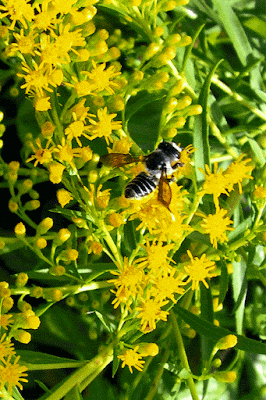I have been weeding in the swale - a 12-15-foot wide area between the property line and the street. It is county right-of-way, but the homeowner has to "maintain" it, i.e. nothing over 18 inches tall. People with lawns generally just let the grass grow to the street, but there was no lawn when we bought the house - just rocks - and there's no lawn now because we went with mulch instead of grass. The swale itself is covered with coarse drainfield rock, and, lamentably, many weeds.
Swales are designed to collect and hold rainwater so it filters down through layers of sand and soil to the groundwater below instead of running directly into a body of water or open land. The middle of the swale, the lowest point connected to our lot, retains some soil moisture even in the dry season. The rock also helps keep the underlying soil relatively cool and moist.
It's no accident that a lot of things want to grow here, especially since the swale is located under the utility lines and gets daily contributions from the birds. Years ago I planted the iris relative blue-eyed grass (
Sisyrinchium angustifolium) along the property line, but it migrated to the swale, which it liked much better, and has flourished and multiplied ever since.
 |
| Blue-eyed Grass, Sisyrinchium angustifolium |
But so have the weeds. In theory you should not pull weeds, because that further disperses their seeds. Cutting them back before they bloom or killing them with herbicide aren't always options for me here, because the grasses and grass-like weeds grow right next to, or even within clumps of the blue-eyed grass, so I end up teasing them out, one by one. It sometimes feels like weeding with tweezers. I just hope that by persevering I eventually will have a blue-eyed grass meadow.
The grasses and sedges are the most troublesome weeds in the swale. They often superficially resemble the blue-eyed grass, and as I mentioned, are competing for the same turf. I really have to pay attention so that I don't inadvertently yank out clumps of the good stuff.
I decided to draw a few of them, and then id them - fat chance! The sedge family,
Cyperaceae, contains at least 5,000 species, and the genus
Carex, the "true" sedges, has over 2000 species. The study of sedges is so complex and specialized that it even has its own name - caricology.
With botanical drawing you sort of have to know what you are looking for before you go looking for it, and I didn't read anything on the sedges until after I had drawn them, so I didn't collect enough detail for anything certain. About all I knew was the mnemonic, "Sedges have edges." Members of the genera
Carex and
Cyperus both have 3-angled stems.
As far as I can tell, I didn't find any
Carex species on this first go-round.
The plant below might be
Cyperus surinamensis, and then again, it might not be. If I've identified it correctly, it's native to Florida.
 |
| Cyperus surinamensis ? - Flatsedge |
The same goes for the sketch below. I simply didn't collect enough information for an id. Just going by superficial resemblance the closest candidate so far would be
Cyperus croceus, "Baldwin Flat Sedge." This species is also native to Florida, but whether it's the one below is an open question.
 |
Cyprus croceus? - Baldwin Flat Sedge?
|
The black-and-white drawing below is a species of Kyllinga, an exotic weed. Due to close similarities, botanists have folded this genus into Cyperus, so newer descriptions would list it as Cyperus brevifolius. This paraticular species grows in mats in the wettest part of the swale. It stays short, definitely under 6 inches tall, and usually much shorter.
 |
Yellow Nut Sedge? and Green Kyllinga
|
I am most confident about my last sedge. I'm pretty sure it is
Cyperus rotundus, "purple nut sedge," or "purple nut grass."This species is sometimes called the "worst weed in the world," because it is so hard to eradicate. Though it's not my most troublesome weed, I have to patrol for it least weekly, or it would take over. You have to pull it low to the ground, or else the top just breaks off, and the plant regenerates from the rhizome. Sometimes, if the soil is loose enough I get a long piece of the rhizome, and as I pull out one plant, another, a few inches away, disappears underground and comes up with the first one - really cool when it happens. Kind of like a botanical magic trick. Plants that haven't bloomed yet make good compost.
 |
| Cyperus rotundus - "Purple Nut Sedge" |
Last but not least, in my first foray, is
Fimbristylis, another genus in Cyperaceae. It sometimes is called "fimbry" or "fringe rush." I have several species in the yard. I don't know what the one below is. The
Fimbrystilis in our yard are rather attractive. They grow in tidy, basal clumps, and their small, pale brown "heads," with a bluish fringe between scales are pretty. I tried leaving some in the swale, but it quickly got out of hand. I may pot some and place them in one of my bog gardens to see if they can be controlled.
 |
Fimbristylis Species
|
I have yet another sedge in a vase, waiting for me to draw it. I don't know whether it is another species, or just an immature specimen. It's quite ornamental, actually. I have a sneaking suspicion that I am getting slightly hooked on the Cyperaceae family. There are many sedges available in the nursery trade, but mine are scarcely likely to be among them.





















































